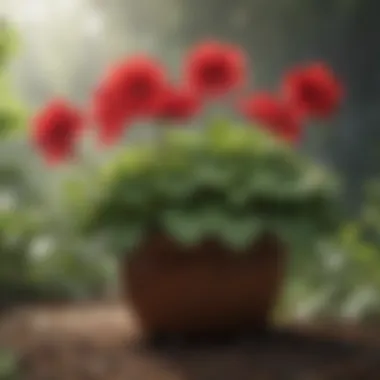A Comprehensive Exploration of Geranium Species


Intro
Geraniums, belonging to the genus Geranium, encompass a wide variety of species appreciated for their unique attributes and ecological contributions. They often draw interest from botanists, horticulturists, and casual gardeners alike. This article aims to provide a thorough understanding of these plants by examining their distinguishing characteristics, habitat preferences, cultivation techniques, as well as their place within culture and art.
The upcoming sections will elucidate the intricacies of geranium species while also offering practical insights for cultivation and care.
Fascinating Facts About Geraniums
Unique Characteristics
Geraniums exhibit a robust diversity that distinguishes them from other shrubs. Many species showcase leaves that are deeply lobed or serrated, contributing to their aesthetic appeal. Flowers, typically five-petaled, display a wide spectrum of colors, including pinks, reds, and purples. Interestingly, some varieties have a pleasant aroma, adding to their horticultural value.
Their leaves often change colors with the seasons, enhancing their ornamental presence in gardens. Additionally, the foliage offers a unique texture that contrasts nicely with other plants.
Ecological Roles
Geraniums hold considerable ecological significance. They attract various pollinators, including bees and butterflies, which contribute to local biodiversity. Moreover, their root systems help in soil stabilization, preventing erosion in their native habitats.
Cultivation and Gardening Tips
Growing Conditions
Geraniums thrive in a range of environments, but certain conditions promote their best growth. Here are a few essential aspects:
- Light: They enjoy full sun to partial shade.
- Soil: Well-drained soil is crucial.
- Water: Moderate watering will prevent root rot.
Common Pests and Diseases
While generally hardy, geraniums can sometimes face challenges from pests and diseases. Common issues include aphid infestations and powdery mildew. It is important to regularly inspect plants for early signs of trouble and address them promptly.
- Regular pruning can reduce disease risk.
- Use organic insecticides when needed.
“Understanding and nurturing geraniums can lead to a rewarding gardening experience.”
Cultural Significance
Influence on Art and Literature
Geraniums have transcended their role as mere decorative plants, finding place in various artistic expressions. Their beauty captured the attention of many artists, often depicted in paintings and literature. They symbolize resilience and beauty, reflecting the human connection to nature.
In folklore, certain species are seen as protectors of homes, believed to bring good fortune.
Synthesis and Finale
Through this exploration, it becomes evident that geranium species are more than just attractive flowers. They play a vital role in ecosystems, offer numerous benefits in horticulture, and inspire various cultural narratives. Whether a gardener or an admirer, understanding these facets of geraniums can deepen one’s appreciation for them, further connecting humanity with the natural world.
Intro to Geraniums
Geraniums hold a unique position in the world of botany and horticulture. Their vibrant colors and diverse forms make them popular choices in gardens and landscapes. Importantly, understanding geraniums goes beyond aesthetics; they serve vital ecological roles and offer various benefits in traditional practices.
In this section, we will explore two significant aspects: the definition and classification of geraniums, and their historical context. This exploration not only provides insight into the biological and environmental significance of these plants but also illuminates their enduring relevance in human culture and history.
Definition and Classification
Geraniums belong to the genus Geranium, in the family Geraniaceae. They are commonly known as cranesbills due to the shape of their fruit. There are around 422 recognized species of geraniums, which are distributed across different climates and regions worldwide. Typically, they are perennial plants, although some species can be annual.
Classifying geraniums can be complex, as they can be divided based on their growth habit, flower structure, and specific adaptations to their environments. Some common classifications include:


- Herbaceous Geraniums: These are known for their lush foliage and colorful blooms. They thrive in temperate regions.
- Woodland Geraniums: Found in shaded forest areas, they exhibit a different growth form suited for low light.
- Crane's Bill Geraniums: Characterized by deeply divided leaves and open flowers, they are popular in ornamental horticulture.
Each species provides unique contributions to their ecosystems, from serving as habitat for pollinators to stabilizing soil.
Historical Context
The history of geraniums is rich and varied. Evidence indicates that they have been cultivated for centuries, particularly in Europe. The ancient Egyptians utilized various geranium species for medicinal purposes. Ancient records mention the use of geraniums in remedies for ailments like wounds and inflammation.
In the 16th century, geraniums began to gain popularity in European gardens, especially with the rise of botanic interest during the Renaissance. Botanists such as John Gerard documented them in their works, leading to a surge in their cultivation.
During the 19th century, exotic varieties were introduced, enhancing their allure in gardens. Furthermore, geraniums became symbols in art and literature, representing both beauty and resilience.
"Geraniums have not only stood the test of time in gardens but have also imprinted themselves on human history through art and culture."
As we explore further sections in this article, the multifaceted attributes of geraniums will reveal their significance, not just as ornamental plants, but as integral components of ecosystems and human enterprise.
The Botanical Characteristics of Geraniums
The exploration of geraniums cannot be complete without understanding their botanical characteristics. This section illustrates how their physical traits and reproductive systems contribute to their success and adaptability in various environments. Recognizing these elements is crucial for anyone interested in horticulture or ecology. It allows for better cultivation practices and enhances appreciation for these remarkable plants.
Morphological Traits
Geraniums possess distinct morphological traits that shape their identity within the plant kingdom. These traits include the form of their leaves, flowers, and overall growth habit.
- Leaves: Most geranium species have palmate or deeply lobed leaves. They're often aromatic. This is not only an aesthetic quality but also a protective adaptation. These features can deter herbivores.
- Flowers: The flowers are usually actinomorphic, meaning they are radially symmetrical. They can come in various colors, including pink, purple, and white. The structure of the flower is noteworthy. They typically have five petals and are arranged in clusters. This enhances pollinator attraction.
- Growth Habit: Geraniums display a variety of growth habits. Some species are sprawling, while others are upright. This variety allows them to occupy diverse ecological niches. The compact forms are popular for urban gardens. In contrast, the sprawling types may serve as ground covers and help prevent soil erosion.
Reproductive Biology
Reproductive biology in geraniums is as intricate as it is fascinating. Their reproductive strategy plays a significant role in their survival and distribution.
- Pollination: Most geraniums rely on insects for pollination. They produce nectar, which attracts bees and other pollinators. The arrangement of the flowers enhances accessibility for these insects, ensuring effective pollination.
- Seed Dispersal: Geraniums have unique seed dispersal mechanisms. The seeds often have a hooked structure, which allows them to attach to animals, facilitating long-distance dispersal. This adaptation is advantageous for colonization in new areas.
- Hybridization: Some species are capable of hybridization. This ability adds complexity to their genetic diversity. Hybrid geraniums may exhibit traits of both parent species. This characteristic can be beneficial in terms of adaptability to changing environments.
A deeper understanding of reproductive biology underscores the ecological significance of geraniums. By ensuring successful reproduction and dispersal, these plants maintain their populations and adapt to varying conditions.
The adaptability and reproductive strategies of geraniums are key factors in their ecological success. Their varied morphological traits make them suitable for a variety of environments, from gardens to wild landscapes.
Varieties of Geraniums
The topic of varieties of geraniums is crucial for understanding the full scope of the genus and its ecological and ornamental significance. Geraniums present a diverse array of species, each with unique characteristics. This understanding not only enriches our appreciation of these plants but also offers insights for effective cultivation and conservation efforts.
Common Species
Common species of geraniums are often found in gardens and landscaping due to their hardiness and aesthetic appeal. Some of the most popular include:
- Geranium maculatum: Also known as the wild geranium, this species is native to North America. It features purple flowers and thrives in shaded environments.
- Geranium pratense: Known as the meadow crane's-bill, it grows well in moist conditions and displays blue to purple blooms that attract various pollinators.
- Pelargonium: Although not true geraniums, these species are commonly classified under the genus and include many cultivated varieties that are popular in households and gardens. They display vibrant colors and have distinctive scented leaves.
These species showcase adaptability to various climates and soil types, making them suitable for a wide range of horticultural applications. Their presence can enhance biodiversity in gardens, supporting pollinators and other wildlife.
Rare and Endemic Species
Rare and endemic species of geraniums play a significant role in maintaining ecological balance and preserving genetic diversity. Examples include:
- Geranium palustre: Found in wetland areas, this species is becoming increasingly rare due to habitat loss. It is important for its role in supporting wetland ecosystems.
- Geranium argenteum: This mountain species is endemic to specific alpine regions and provides unique ecological niches for various wildlife.
Endemic species such as Geranium argenteum highlight the specialized adaptations of flora to unique environments. Understanding these adaptations is crucial for conservation efforts.
- Geraniums of Mauritius: Some species are only found on this island. Their unique genetic traits are valuable for studies in evolution and conservation biology.
Rare and endemic species often require specific conditions to thrive. Protecting their habitats is vital for maintaining biodiversity. Researchers and conservationists must pay attention to these varieties to ensure they do not become extinct, which would result in loss of not only the plants but also the ecological roles they fulfill.


Ecological Significance of Geraniums
Geraniums play a pivotal role in their ecosystems, functioning beyond mere ornamental value. This section focuses on their contributions to biodiversity and ecological stability, which is critical for preserving habitats and supporting a diverse range of species.
Role in Ecosystems
Geraniums contribute to ecosystems in several notable ways. Their presence serves as an important food source for pollinators such as bees and butterflies. This interaction not only aids the geranium's reproductive processes but also supports the broader ecosystem by ensuring the survival of these vital pollinator species. In the spring and summer months, geraniums provide nectar and pollen, fostering pollination and encouraging plant diversity.
Additionally, they contribute to soil health. Geraniums, particularly species that grow densely, prevent soil erosion. Their root systems bind the soil, reducing the risk of degradation, especially in hillside areas. This stabilization is particularly important in regions prone to heavy rains.
Moreover, geraniums can positively influence soil composition. They can release organic compounds that enhance nutrient availability, helping other plants thrive in their vicinity. Their organic matter, when decomposed, enriches the soil, benefiting future plant growth.
Interactions with Other Species
The interactions between geraniums and other species highlight their ecological importance. On one hand, they interact with insects vital for pollination. On the other hand, they engage in competition with neighboring plants, which can reveal insights into adaptive survival strategies.
Specifically, geraniums engage with a variety of herbivores. While some insects may feed on geranium leaves, these plants often develop natural defenses. For example, certain geranium species produce compounds that deter herbivores. They have evolved to balance their roles within the chain of life, simultaneously supporting other species while safeguarding their own health.
Furthermore, many birds and small mammals rely on geraniums for cover and food. The dense foliage provides protection from predators and serves as a habitat for various species. This dynamic accentuates the multifaceted roles geraniums play in habitat composition and health.
In ecosystems where geraniums are abundant, they contribute to the rich tapestry of life. Their interactions with various organisms underscore their essential position within the ecological web.
“Geraniums are not merely plants; they are ecosystems in themselves, providing critical support for countless species.”
Cultivating Geraniums
The cultivation of geraniums holds significant value not only for horticulturists and gardeners but also for anyone interested in enhancing the aesthetic appeal of a space. Various factors contribute to the successful growth of these plants. Understanding their specific needs is essential. Proper cultivation can lead to robust, vibrant plants, which often serve as a focal point in gardens and indoor settings. The following sections will delve deeper into their specific requirements and best practices for growth.
Soil and Nutrient Requirements
Geraniums thrive in well-drained soil rich in organic matter. The optimal pH range for this species is between 6.0 and 7.0. Using a mix of potting soil with compost can provide the necessary nutrients. Geraniums also benefit from balanced fertilizers, particularly during the growing season. These include ingredients like nitrogen, phosphorus, and potassium. Over-fertilizing can lead to lush foliage but poor flowering, so it is crucial to adhere to recommended application rates.
- Key Considerations:
- Ensure good drainage to prevent root rot.
- Monitor soil moisture regularly.
- Organic compost can enhance soil quality.
Using the right soil mix can enhance growth significantly.
Watering and Light Conditions
Watering practices are crucial to the health of geraniums. They prefer to be on the drier side than too wet. Overwatering can lead to various issues, such as root rot. A general rule is to water when the top inch of soil feels dry. When it comes to light, geraniums thrive in bright, indirect sunlight. However, too much direct sunlight may scorch the leaves. In a controlled environment, placing them near east or west-facing windows can provide adequate light.
- Watering Tips:
- Water thoroughly but let the soil dry out between watering.
- Adjust watering frequency based on humidity levels.
Best Practices for Growth
To ensure geraniums reach their full potential, there are several best practices to follow. Regular deadheading, which is the removal of spent blooms, encourages more flowering. Pruning can also help shape the plant and remove any dead or diseased sections. Additionally, monitoring for pests and diseases is essential. Frequent inspections can catch issues early, leading to better control outcomes.
- Growth Tips:
- Deadhead regularly for continuous blooming.
- Prune as necessary for health and shape.
- Inspect plants frequently for signs of pests like aphids or spider mites.
By understanding these key elements of cultivating geraniums, both novices and experienced gardeners can enjoy the rich beauty and diversity these plants contribute to their environments.
Pests and Diseases Affecting Geraniums


Understanding the pests and diseases that can affect geraniums is essential for any gardener or horticulturist. These elements not only hinder the growth and the aesthetic value of the plants but can also lead to their decline if not managed effectively. By addressing pests and diseases, we can ensure that these plants remain vibrant and healthy, contributing to their ecological and ornamental value.
Common Pests
Geraniums are susceptible to various pests, which can cause substantial harm to their growth. The most notable include:
- Aphids: These small, soft-bodied insects can cluster on new growth and under leaves, sucking sap and potentially causing deformation.
- Spider Mites: Often unnoticed initially, spider mites can lead to yellowing leaves and produce webs, indicating significant infestations.
- Whiteflies: These tiny, white insects reside on the undersides of leaves and can weaken the plant by feeding on sap, which may lead to wilting and stunted growth.
- Mealybugs: Similar to aphids, mealybugs are waxy and can create a sticky residue that attracts other pests, inviting fungal diseases.
It is crucial to monitor your geraniums regularly for any signs of these pests. Early detection can significantly reduce the potential damage. Different control methods include:
- Insecticidal Soap: Effective against softer-bodied insects, it disrupts their cell membranes on contact.
- Horticultural Oil: This can suffocate many insects and prevent infestations.
- Neem Oil: Known for its multiple functions, neem oil acts both as a preventive and a cure.
Diseases and Treatment Options
Geraniums face various diseases that can impair their health. Some common diseases include:
- Botrytis Blight: This fungal disease causes gray mold on flowers and stems, thriving in humid environments. Preventive measures include ensuring proper air circulation and avoiding overhead watering.
- Powdery Mildew: Another fungal issue, powdery mildew appears as a white, powdery coating on leaves. Good spacing and selecting resistant varieties can help.
- Root Rot: Occurs due to overwatering and poor drainage, leading to dark, mushy roots. Ensuring soil drainage and allowing the soil to dry out between waterings is vital.
Treatment options vary based on the disease. For instance:
- Fungicides may be employed for treatments. Specific products should be chosen based on the type of fungus identified.
- Cultural Practices such as crop rotation and plant disposal can prevent further outbreaks.
By implementing these pest and disease management strategies, gardeners can maintain the health of geraniums, preserving their natural beauty and ecological importance.
Cultural and Artistic Importance of Geraniums
Geraniums have a multi-dimensional role in culture and art, extending well beyond their aesthetic appeal. Their presence in various forms of expression reflects an enduring connection between nature and humanity. These plants have been celebrated not just for their bright colors and fragrances but also for their deeper meanings and uses in traditions and practices across the globe.
Representation in Literature and Art
Throughout history, geraniums have found their way into many artistic expressions. In literature, they symbolize resilience and tenacity, often representing the human spirit in the face of adversity. Writers have used them as metaphors for personal growth and transformation. For instance, in the works of naturalists, descriptions of geraniums are woven with themes of endurance in challenging environments.
In visual arts, geraniums are a popular subject due to their vivid colors and intricate forms. Famous paintings from the Impressionist era often feature these blossoms, highlighting their ability to evoke emotion and vibrancy. Artists such as Claude Monet prominently showcased geraniums in his garden scenes, using their colors to enhance the overall composition.
Their symbolic meanings are often rich and varied; in some cultures, geraniums are seen as tokens of good luck and fertility. This cultural significance can elevate their role beyond mere decorative plants to profound symbols that resonate with communal values and beliefs.
"Geraniums are not just plants; they carry stories and meanings that have spanned centuries."
Geraniums in Traditional Medicine
Geraniums are not only artistically important but also hold a place in traditional medicine. The leaves and roots have been used in various cultures for their purported medicinal properties. For instance, extracts from certain geranium species contain compounds that are believed to have anti-inflammatory and astringent effects. In folk medicine, geranium leaves were commonly applied to skin irritations and minor wounds.
Various cultures have associated specific species with unique healing practices. For example, the African Geranium, often linked to traditional healing rituals, is recognized for its role in alleviating ailments like headaches and respiratory issues. Similarly, the potent aroma of geraniums has been utilized in aromatherapy, where their essential oils are believed to reduce stress and promote emotional balance.
The divergence of uses highlights the versatility of geraniums in human culture. This medicinal aspect emphasizes that their importance is multifaceted, underscoring a connection not just to beauty but also to well-being and health.
Finale
The conclusion of this article serves crucial purpose in framing the broader implications of geranium species within various contexts. It synthesizes the insights uncovered throughout the previous sections, allowing readers to appreciate geraniums not merely as decorative flora but as pivotal components in ecosystem dynamics, cultural narratives, and horticultural practices.
Understanding what has been covered is essential. Key points include the botanical characteristics of geraniums, highlighting their diverse morphological traits and reproductive strategies. Awareness of the ecological significance reveals their role in sustaining ecosystems and interacting with numerous species. Furthermore, cultivating practices described earlier equip both novice and experienced gardeners with the knowledge needed to promote healthy growth and reduce the impact of pests and diseases. The cultural significance opens avenues for appreciation in literature, art, and traditional medicine, ensuring that geraniums occupy a distinct place in human history.
As we summarize these key elements, it becomes clear that geraniums offer more than mere beauty; they present opportunities for environmental stewardship and cultural reflection. By recognizing the multifaceted interactions between humans and geranium species, we can foster a deeper connection with our natural surroundings.
Summary of Key Points
- Botanical Diversity: Understanding the variety within the genus gives insight into their adaptability and requirements.
- Ecological Role: Geraniums contribute to ecosystem health, providing habitat and food for various organisms.
- Cultivation Knowledge: Successful gardening of geraniums hinges on specific practices and awareness of environmental needs.
- Cultural Impact: Their presence in art and traditional medicine denotes a historical relationship with humans that extends beyond aesthetics.
Future Directions for Research
Looking ahead, research into geranium species can significantly contribute to a range of fields. Several future directions warrant attention:
- Genetic Studies: Investigating genetic diversity among species can help improve disease resistance and adaptability.
- Ecological Impact Research: More studies can explore the specific interactions geraniums have within their ecosystems, particularly in changing climates.
- Cultural Studies: Further exploration into their representations in various cultures may uncover stories and significance yet to be widely recognized.
- Sustainability Practices: Research focused on sustainable cultivation methods can provide insights that balance horticultural practices with environmental conservation.
Engaging in these areas paves way for a more comprehensive understanding of geranium species, enhancing not only horticultural practices but contributing to environmental, cultural, and social well-being.







